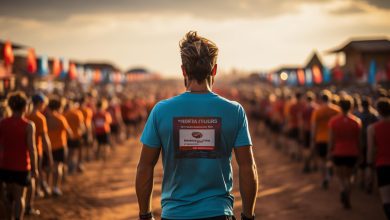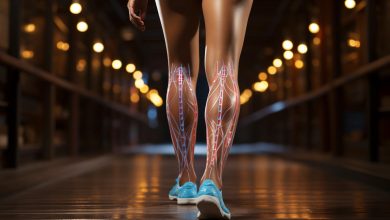Recovering From 10K Races: Tips for Optimal Rest and Rehabilitation

Imagine crossing the finish line of a grueling 10k race, your muscles burning and your body exhausted. But the journey isn’t over yet. Now, it’s time to focus on recovery – giving your body the care it needs to bounce back stronger than ever.
In this article, we will guide you through the essential tips for optimal rest and rehabilitation after a 10k race. From setting realistic goals to nourishing your body with proper nutrition, we’ve got you covered every step of the way.
Setting Realistic Recovery Goals

When setting recovery goals after a 10k race, it’s important to be realistic and take into account your current fitness level. Gradual progression is key in ensuring a safe and effective recovery process. Pushing yourself too hard or expecting immediate results can lead to injury or burnout. Instead, focus on gradually increasing your activity level and intensity as your body allows.
Listening to your body is crucial during the recovery phase. Pay attention to how you feel physically and mentally, as this will guide you in determining the appropriate pace for your rehabilitation. If you experience excessive fatigue, soreness, or any unusual pain, it’s essential to give yourself adequate rest and modify your training accordingly.
Remember that every individual’s recovery journey is unique. While some may bounce back quickly after a 10k race, others may require more time and patience. Comparing yourself to others or setting unrealistic expectations can hinder progress and dampen motivation.
Set specific recovery goals that align with your personal fitness level and aspirations. Whether it’s focusing on active rest days, incorporating cross-training exercises, or gradually increasing mileage each week, tailor your goals to suit your needs while promoting steady improvement.
The Importance of Active Rest

Taking time to engage in light physical activity is crucial for allowing your body to recover effectively after a 10k race. Active rest, as it is commonly referred to, involves engaging in low-intensity exercises that promote blood flow and aid in the repair and regeneration of muscles. While it may be tempting to simply lie on the couch and do nothing after a race, incorporating active rest into your recovery routine can greatly enhance your overall rehabilitation.
Active rest can include activities such as gentle stretching, walking or cycling at a leisurely pace, or even practicing yoga. These techniques help flush out metabolic waste products from your muscles while promoting circulation and reducing muscle soreness. By keeping your body moving through light exercise, you encourage the delivery of oxygen and nutrients to the muscles, which aids in their recovery.
Transitioning into the subsequent section about ‘nutrition for recovery: fueling your body,’ it’s important to note that active rest alone is not enough to fully recover from a 10k race. In order to optimize your recovery process, you must also pay attention to what you eat. Proper nutrition plays a vital role in replenishing glycogen stores, repairing muscle tissue damage, and supporting overall healing. So let’s dive into the next topic and explore how you can fuel your body for optimal post-race recovery.
Nutrition for Recovery: Fueling Your Body

To properly replenish your body after a 10k race, it’s essential that you focus on fueling yourself with the right nutrients. Post-race hydration is crucial to replace the fluids lost through sweat and maintain optimal performance. Make sure to drink plenty of water and consider incorporating electrolyte-rich drinks or coconut water into your routine. Additionally, consuming essential supplements can aid in recovery and support overall muscle repair.
Here is a table outlining some key nutrients and their benefits for post-race recovery:
| Nutrient | Benefits |
|---|---|
| Protein | Repairs muscles and promotes growth |
| Carbohydrates | Replenishes glycogen stores |
| Omega-3 fats | Reduces inflammation |
| Antioxidants | Fights oxidative stress |
Including foods rich in these nutrients such as lean meats, whole grains, fatty fish, fruits, and vegetables into your post-race meals can contribute to faster recovery. Moreover, consider adding protein shakes or bars as a convenient way to meet your protein needs.
Transitioning into the subsequent section about restorative techniques for muscles and joints, proper nutrition sets the foundation for an effective recovery plan. However, it’s equally important to incorporate restorative exercises and therapies that target muscle soreness and joint stiffness.
Restorative Techniques for Muscles and Joints

For effective muscle and joint recovery, it’s important to incorporate restorative techniques that target soreness and stiffness. By implementing these muscle recovery techniques and joint rehabilitation strategies, you can optimize your body’s healing process and get back to peak performance in no time.
Here are some restorative techniques that will help soothe your muscles and joints:
– Foam rolling: This self-myofascial release technique uses a foam roller to apply pressure on tight areas of the body. It helps break up knots in your muscles and improve blood flow, reducing pain and promoting faster recovery.
– Stretching: Incorporating dynamic stretches before exercise and static stretches after can help increase flexibility, reduce muscle tension, and prevent injuries.
– Hot/cold therapy: Alternating between hot and cold treatments can aid in reducing inflammation and speeding up recovery. Use heat packs or warm baths to relax stiff muscles, followed by ice packs or cold showers to decrease swelling.
And here are some joint rehabilitation strategies that will promote healing:
– Low-impact exercises: Engaging in activities like swimming or cycling puts less stress on your joints while still allowing movement. This helps maintain strength without causing further damage.
– Physical therapy: Working with a professional who specializes in joint rehabilitation can provide personalized exercises that target specific problem areas. They may also use modalities such as ultrasound or electrical stimulation to accelerate healing.
Incorporating these restorative techniques into your routine will not only alleviate soreness but also enhance overall performance. Take care of your muscles and joints so they can continue supporting you on every step of your fitness journey.
Mental Strategies for Post-Race Rehabilitation

After completing a race, it’s important to focus on mental strategies that can aid in the post-race rehabilitation process. One of the key aspects of this recovery is utilizing relaxation techniques and mindfulness training.
These practices can help you restore your mental well-being and enhance your overall performance.
Relaxation techniques such as deep breathing exercises, progressive muscle relaxation, and guided imagery can help calm your mind and reduce stress levels. By consciously relaxing each muscle group in your body, you promote the release of tension accumulated during the race. This promotes faster healing and reduces the risk of injury.
Mindfulness training involves being fully present in the moment without judgment. It allows you to acknowledge any negative thoughts or emotions that may arise after a race, while also creating space for positive affirmations. Practicing mindfulness can improve your ability to cope with discomfort or setbacks during the recovery process.
Incorporating these mental strategies into your post-race rehabilitation routine will not only expedite physical recovery but also contribute to your overall well-being. Remember to allocate time for relaxation techniques and mindfulness training alongside physical rest to optimize your restorative process.
Conclusion
So, you’ve just completed a grueling 10k race. Congratulations!
Now it’s time to kick back, relax, and let your body recover. Remember, setting realistic recovery goals is key.
Take advantage of active rest to keep those muscles limber and prevent any post-race stiffness.
And don’t forget about nutrition – fueling your body with the right foods will help speed up the healing process.
Lastly, try out some restorative techniques for those tired muscles and joints.
And remember, mental strategies are just as important as physical ones in your post-race rehabilitation.
So go ahead, take a well-deserved break and come back stronger than ever before!






